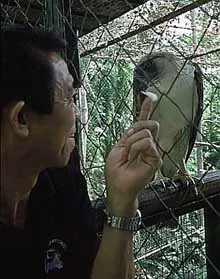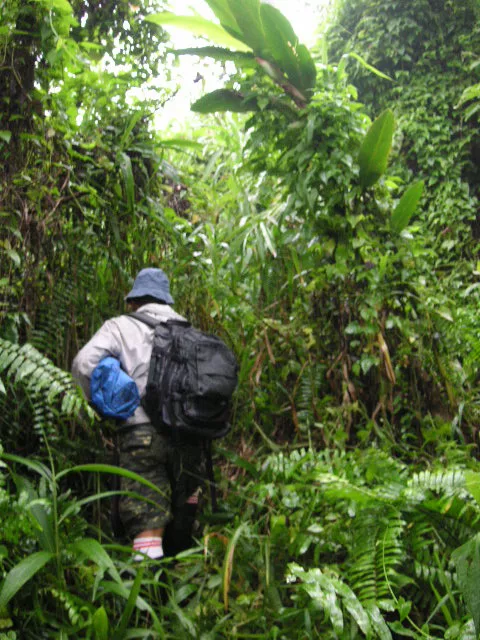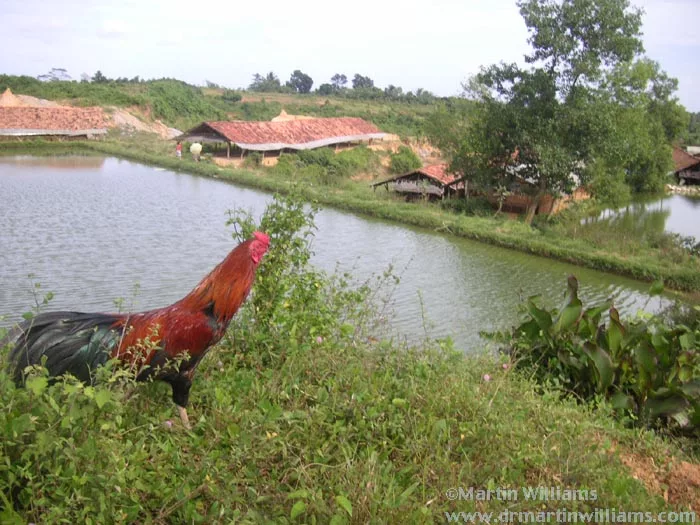I’m travelling to meet people working to save the remaining forests of Borneo, which was described Charles Darwin as, “One great untidy luxuriant hothouse made by nature for herself.”

Whoop. Whoop-whoop! Woo-oo-oooo-ooooo. The forest resounds to a loud, haunting song: the duet of a pair of Bornean gibbons, exuberant as children at a party. I glimpse the two grey primates as they move through leafy branches, swinging gracefully as gymnasts with long slender arms.
Loud honking in trees to my left announces the presence of one of the world’s greatest rainforest birds, a rhinoceros hornbill. Well over a metre long, it’s mainly black, with a long pale bill topped by a brilliant orange casque that curls up like a small horn. It honks louder and faster, and I hear air whooshing through wings, as it switches trees.
A red ribbon on a sapling indicates where, three months earlier, a researcher looked up to see leafy branches folded together: the temporary nest of a Bornean orang-utan. Nearby, a Rajah Brooke’s birdwing – a magnificent butterfly with a shining green band across its long, otherwise jet-black wings, and a red front body – glides across a stream.
Towards sunset, it seems the air is filled with flying Geiger counters, as swiftlets chasing tiny insects emit double-clicks. They belong to only two families of birds that employ echolocation. At night, there’s a continual chorus of chirps and ringing chirrups from tree frogs and crickets.

As my overnight stay indicates, this forest deep within the world’s third largest island, Borneo, boasts magnificent biodiversity. But this is no paradise, for though I’m in a national park I also see the stumps of trees felled by illegal loggers. Elsewhere, swathes of forest have been cleared.
I’m visiting Borneo to learn about the deforestation and its impacts on wildlife and human lives. And to meet people working to save the remaining forests of Borneo, which was described by the great 19th-century naturalist Charles Darwin as, “One great untidy luxuriant hothouse made by nature for herself.”
Moving at the Speed of the Threats
Stuart Chapman is a man in a hurry. The tall, 41-year old Briton is the international coordinator of the Heart of Borneo, an ambitious project the World Wildlife Fund (WWF) initiated in 2003.
“The Heart of Borneo is built around what remains of what was essentially a forested island fifty years ago,” says Chapman, when we meet in the Jakarta office of WWF Indonesia. “From 1985 to 2005, huge areas of forest disappeared, and now all that’s left of wild Borneo is this large, continuous patch.”
Covering 220,000 square kilometres of north Borneo – over one and a half times the size of New York State; just larger than Great Britain – the project area is shared by Brunei, Malaysia, and Indonesia. Chapman is seeking to move at a speed matching the threats, to ensure all three countries cooperate in safeguarding the Heart of Borneo.
Those threats can move very rapidly. In July 2005, Chapman and colleagues were startled by a news report announcing plans for the world’s largest oil palm plantation, in Kalimantan – Indonesian Borneo, threatening to wreck the Heart of Borneo before the project officially began. Oil palms are widely grown in the lowlands of Malaysian Borneo, but this new plantation would be mainly in hills. “We asked the industry, ‘Can you grow oil palms up there?'” says Chapman. “The overwhelming answer was: ‘No.’ Our assessment was that this was a scam for clearing timber on a very large scale.” WWF showed there were large areas of idle land suitable for oil palms, and the Indonesian government halted the project.

Borneo’s rainforests are special partly as they span the Equator, leading to high biodiversity. Animals found here include Bornean orang-utan, proboscis monkey, Borneo pygmy elephant, Sumatran rhinoceros and clouded leopard. During the last ten years, new species have been discovered at the rate of around three a month, says Chapman. “And these are not just protozoa; they include beautiful orchids.” Extracts from Borneo plants show promise in combating diseases including malaria and AIDS.
Additionally, Chapman says, “Fourteen of Borneo’s 20 major rivers originate in the Heart of Borneo. This makes it hugely significant to the economy of the island.” In WWF’s discussions with governments, the forests’ role in moderating floods and releasing water during dry spells has been a key issue.
Though half the project area is classed as protected, much of the remainder is divided into logging concessions. For the Heart of Borneo to succeed, the logging must be sustainable, with selected trees felled, and associated damage minimised. Chapman believes there is a tremendous opportunity to brand the wood, so people buying Heart of Borneo products can make a positive contribution to the forests.
The Lungs of the Planet
In northeast Kalimantan, Indonesian Borneo, I travel up a river inhabited by crocodiles, to Malinau, the island’s best forested district. “Over 90 percent of Malinau is forest,” says Junus Paddalah, head of the district’s Environmental Management Body. He wears an almost military style, khaki uniform – but instead of warfare, Paddalah is engaged in the struggle to balance forest protection and economic development.
The local government has declared Malinau a conservation district. “We regard it as the lungs of the planet, providing oxygen,” says Paddalah. Yet timber is the main source of ready income. The government is seeking alternatives, such as through sustainable farming and ecotourism, and receiving money for environmental services including protecting river catchments.
“The world blames us for cutting trees, but without giving us solutions,” says Paddalah. “We need guidance from the national government and other bodies – how can we survive if we don’t cut the trees?”

The village that said No to the loggers

Though even parts of landlocked Malinau have suffered from over-zealous logging, there are places where local people have decided it was better to keep forests than sell timber rights to loggers. Setulang is the best-known such place: a village of wooden houses, built on stilts, which is home to over 800 Dayaks – indigenous Borneo people – who grow crops including rice and coffee, and hunt bearded pigs and gather plants such as rattan in a neighbouring patch of primary forest.
One afternoon in 2000, the villagers gathered in their meeting hall, to discuss a timber company’s offer of US$300,000 for rights to their forest. Surrounded by paintings on walls and doors showing leopards, hornbills, and hunters with blowpipes, they listened as individuals aired their views.
At first, most young men said yes to the money, which was a substantial sum for a village based on subsistence farming.

The elders advised caution. Philius Unyang – a genial man whose living room walls are decorated with ceremonial shields, headdresses and capes made of bear skins and hornbill feathers, with a shelf-full of trophies testifying to his prowess at traditional dancing – said that like many Setulang men, he had worked as a logger in Sarawak, northwest Borneo. “They cut the forest, and there is nothing left,” he said. “What will happen here, if there is nothing left of our forest? We must protect our resource if we want clean water. There will be no pigs if there is no forest.”
Swayed by such reasoning, the villagers agreed they would protect their forest. Setulang has since received support from the Center for International Forestry Research (CIFOR), which helped the village receive a national environmental award. Unyang is proud of this recognition, proud that while some other villages sold logging rights to companies that cheated them – such as by failing to deliver on promises to irrigate fields and build a church – Setulang has built its own meeting house and church without outside help.
Citizens have a right to protect our forests

Luther Tare’s friends and family said he was crazy when he marked off his own patch of forest, to safeguard it from loggers. A slender man who looks more like a schoolteacher than someone who takes on powerful companies, he grew up in a village near Malinau town. “We depend on forests,” his parents told him. “All human needs come from natural resources.”
Logging companies arrived in the area during the early 1970s, and Luther went to see how they operated, finding that as larger trees were extracted, younger trees were also destroyed. Like other locals, Tare felt powerless as forests were damaged, streams became siltier, wildlife such as pigs became scarcer.
After college, Tare worked in Sabah, northeast Borneo. On returning home in 1992, he found an area of forest that was unclaimed by villages, and marked out 300 hectares as his own. He went to the main logging company, and said, “You have a right to cut trees, but I hold this land according to traditional rights.” He told local officials, “Citizens have a right to protect our forests,” – and threatened to go higher if they disagreed. The timber companies and officials respected his rights.

Tare regularly patrols his forest, recently co-opting family members to help. He enjoys being in the forest, which he has named the Mitra Alam – Partnership with Nature Forest. He finds the air cooler, likes seeing the wildlife and the big trees, feels healthier after spending time there.
Loggers have sometimes approached Tare, offering to buy timber rights. One came to his house, put a wad of cash on the table and said it was 500 million Rupiahs (US$54,000) towards the timber rights. “Please take it back, as I am not interested,” Tare told him. He hopes future generations will continue protecting the forest.
Now, CIFOR is encouraging more communities to follow examples such as Setulang and Luther Tare, and likewise look after local forests.
Rehabilitating orang-utans and forest
Further south, I call in at the eastern headquarters of the Borneo Orang-utan Society (Borneo Orang-utan Survival). Here, orang-utans rescued from captivity await return to the wild – if suitable forests can ever be found for them, and providing they haven’t caught human diseases such as hepatitis.
There’s a 2000 hectare site, on rolling lowlands that are readily reached – so were long since stripped of most timber. “Logging was fast and furious here,” says BOS primatologist Raffaela. A few fair sized trees did survive, but the fires that swept over much of Kalimantan in 1997 burned here too, leaving only small copses, and charred stumps amidst expanses of alang alang – a hardy grass that readily burns. It’s a landscape that’s all too typical in lowland Kalimantan.

Five years ago, despite scepticism from some who believed the alang alang was here to stay, BOS began reforesting this area; employing local villagers to dig small holes, add compost, and plant seedlings. Now, young woodland covers much of the area. In the dry season, CCTV cameras are part of continual monitoring for fires; teams are always on stand-by lest smoke is seen in the surroundings.
Streams are improving, and BOS will build small reservoirs, to augment the already strained water supply for a nearby city. The district government wants them to similarly reforest two other areas.
On the conservation frontline

I fly west, to Putussibau district, source of West Kalimantan’s main river, the Kapuas. A severe dry season is yet to end, and the Kapuas is so low that boats rest on
mudflats. Probably as a result of deforestation, the river has become more extreme – in the rainy season, it floods more readily – and people living near it are suffering impacts. There are daily power cuts in Putussibau town, as boats can’t bring oil for the power station.
Downstream, the city of Pontianak at the mouth of the river is also short of fuel. The main river channel has shifted away from the city’s water intake, which now draws a mix of river and seawater. “The water tastes bad, so people are drinking mineral water,” says Hermayani Putera, who heads the WWF Putussibau team.
Established a decade ago, the team originally focused on a national park, Betung Kerihun, but now works throughout the district. Putera joined after learning WWF wasn’t only focused on wildlife, but on ensuring nature conservation can also benefit people. “For local people, the forest is part of their life,” he says. “For some ethnic groups, deforestation is the same as destroying their culture.”

He encourages his staff to solve problems through dialogue rather than confrontation. But here on the conservation frontline, even dialogue can be risky. Putera’s team gathered information on illegal logging, helping lead to a clampdown by the national government. In 2005, a band of angry illegal loggers came to town, looking for the WWF office: all the staff left town for a month. The loggers agreed to go, but only after one told Putera, “Someday, we’ll meet again in the forest. And it’s kill or be killed.”
This is the time for conservation
I ride pillion on a motorbike for three hours, to the edge of Betung Kerihun National Park. En route, fires smoulder in clearings cut from young woodland – when the rains arrive, farmers will grow rice, fertilised by ash. Innumerable other fires are burning in fields and plantation clearings across Kalimantan, creating dense, choking haze.
Albertus Tjiu, the WWF researcher whose ribbon I see on the sapling, arranges my foray into the park, and invites me to join a meeting in a village the next evening.
A moth bounces against a fluorescent tube that illuminates part of the terrace of the village longhouse, where village elders, women and children sit on bamboo mats, facing a small team of conservationists including Tjiu.
“We are proud that you have come to our longhouse,” says the traditional village leader, before adding, stern-faced, “We feel left out; we need help with our livelihoods, with education.” Though several villagers express misgivings about the park, they remain attentive, and agree to a follow-up meeting. The kids, especially, avidly watch a video Tjiu has brought, about an orang-utan being returned to the wild.

Here in a longhouse beside forest, I feel I’m in the spiritual heart of Borneo. The WWF project title seems particularly apt as the expanse of forested hills plays such a key role in circulating water that’s essential to life throughout the island. It is imperilled, yet people from villagers to presidents are striving to protect the forests.
“I think this is our time to do conservation,” says Tjiu. “The illegal logging has stopped. Now – this is our time.”
More Info:
WWF – Heart of Borneo
Center for International Forestry Research (CIFOR)
Borneo Orangutan Survival International (BOS)
Samboja Lodge – place where you can stay at Wanariset, the BOS sanctuary I visited, near Balikpapan in east Kalimantan. Here, can help work to save orangs.






















